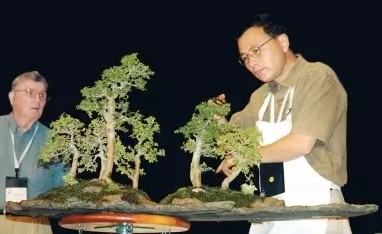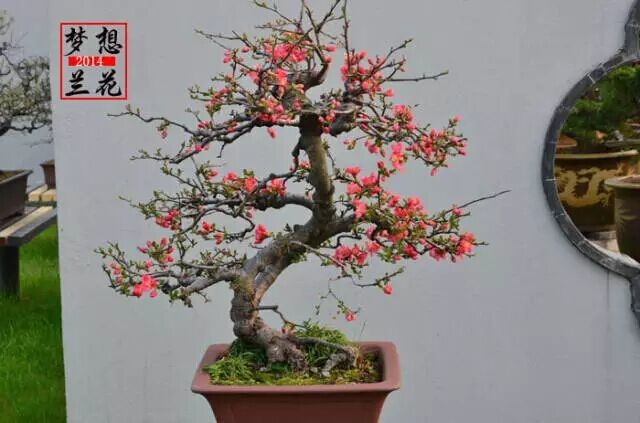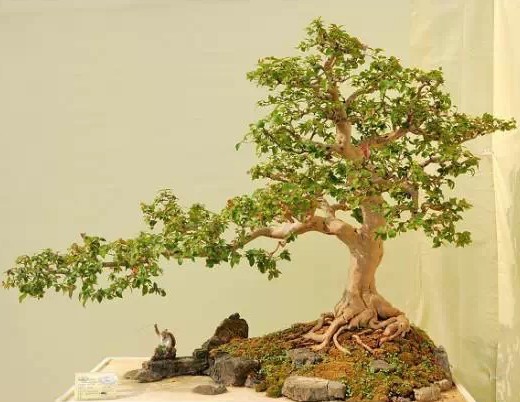Zhao Qingquan, a master of Chinese bonsai art, shows the world the Yang bonsai
Without high-hanging eye-catching signs and luxurious decoration, Master Zhao Qingquan's studio, hidden in a corner of the Bonsai Museum in the thin West Lake, appears to be quite simple and low-key.

When the reporter entered Zhao Qingquan's office, he was on the phone with Su Yiji, former president of the International Bonsai Association and a famous bonsai appreciator in Taiwan, to discuss matters related to the upcoming 2013 International Bonsai Congress and the 50th anniversary celebration of the International Bonsai Association in Yangzhou. The whole interview process is interrupted by phone calls from home and abroad from time to time.
For this grand event held in Yangzhou, Zhao Qingquan made use of his influence and contacts in the international bonsai community to do a lot of work for the success of Yangzhou's bid. Over the past 30 years, Zhao Qingquan has traveled around the world and conducted hundreds of bonsai demonstrations abroad to "show" the elegant demeanour of Chinese bonsai to the world.
A choice with no regrets: give up the college entrance examination for bonsai
The teacher told me that bonsai kung fu is outside the poem. I suddenly understand that no matter how high the skill is, in the end, I will only become a craftsman and create with art.
Bonsai is one of the traditional Chinese arts, known as "silent poetry, three-dimensional painting". The development of Yangzhou bonsai is almost synchronized with that of Chinese bonsai. When it comes to Yangzhou bonsai, people will certainly think of Master Zhao Qingquan.
Zhao Qingquan was born in Yangzhou in 1949. His father was the owner of a private photo studio in Yangzhou. He loved bonsai flowers and plants and later founded a flower and tree shop, later known as the Red Garden. Nurtured by his family environment, Zhao Qingquan has been fond of bonsai since childhood. "at that time, enthusiasts often came to the house to get together to learn the skills of bonsai." Zhao Qingquan said.
After graduating from high school, Zhao Qingquan was sent to the countryside and still likes to play with bonsai. In 1978, as a talent with special expertise, he recruited workers to return to the city and went to the Red Garden to engage in bonsai production.
"apart from my father, I was deeply influenced by my teacher Xu Xiaobai, a professor at the Agricultural College of Yangzhou University and an expert in bonsai." Zhao Qingquan said that Xu Xiaobai was the president of the Chinese Bonsai artists Association and one of the leaders in the theoretical study of bonsai in China. "in addition to gardening, he instructed me to study in many aspects, including literature, poetry, painting and aesthetic theory. The teacher told me, "bonsai kung fu is outside the poem." "I suddenly understand that no matter how high the skill is, in the end, you just become a craftsman and use art to create is the highest level."
Zhao Qingquan grew rapidly with the guidance and practical operation of famous teachers. At this time, a test related to his own future came: the resumption of the college entrance examination, while Xu Xiaobai just received an offer from the publishing house, and the elderly Xu Xiaobai invited his beloved apprentice to cooperate. "according to my grades, I should be able to be admitted to the university, but after much consideration, I decided to give up the college entrance examination." Recalling the past, Zhao Qingquan sighed very much. what he considered at that time was that if he went to college, he might have to change careers later, and I was unwilling to give up bonsai. Besides, writing a book was a process of comprehensive learning. "up to now, I have not regretted my choice." This bonsai monograph "Bonsai" has been printed four times, a total of 240000 copies, which was astronomical at that time.
An unforgettable trip abroad: to bring Chinese bonsai to the world
In the international bonsai world, Zhao Qingquan has become a banner of Chinese bonsai. The voice of "China is the founder of bonsai art" has also been gradually recognized internationally.
Chinese bonsai art has regained its vitality with the pace of reform and opening up. As a representative of Chinese bonsai circles, Zhao Qingquan was the first to enter the international stage.
"Chinese bonsai has a history of at least 1,300 years, but 30 years ago, the international bonsai community believed that bonsai art originated in Japan." On April 21, 1980, Zhao Qingquan, in his prime, went to Osaka, Japan to attend the World Bonsai Conference and give a speech. This is the first time he has gone abroad to preach Chinese bonsai to the world. In Japan, he was shocked by the skill level and international influence of modern Japanese bonsai, which confirmed the idea of "making Chinese bonsai go to the world."
At that time, Japanese bonsai was already popular on the world stage. "after the representatives of each country have made a speech, they will say," Thank Japan for creating a beautiful bonsai art. " This scene made Zhao Qingquan very depressed. when it was his turn to speak, he introduced to the guests that the mural of the Tang Dynasty tomb in China reflected the bonsai scene in the court at that time, which shows that bonsai art has a history of at least 1,300 years in China. "the history of Japanese bonsai art is less than 1000 years old. Zhao Qingquan's speech attracted the attention of the participants. On the sidelines of the meeting, a professor from the University of Hawaii in the United States specifically approached Zhao Qingquan and said, "We really didn't know that bonsai has such a long history in China." "
Subsequently, whenever he had the opportunity to go abroad, Zhao Qingquan would show the breadth and depth of Chinese bonsai to foreigners with blond hair and blue eyes: in 1988, he held eight lectures in Paris, France, which attracted many bonsai lovers in Europe; in 1991, he was invited by eight American bonsai associations to give lectures on a three-month tour in the United States. In 1993, he was invited to give a live demonstration at the second World Bonsai Congress, and his superb skills won warm applause from the audience....
"as far as technology is concerned, the Japanese are doing very well, and foreign bonsai associations pay you to show you to see the history and culture behind your bonsai creation. Over the past few decades, Zhao Qingquan has attended the World Bonsai Congress many times and gave demonstration performances at the conference. He has also been invited to France, the United States, Canada, Italy, Spain, Australia, New Zealand, Venezuela, India, Malaysia, Indonesia and other countries to give more than 100 lectures abroad.
These activities not only expand the influence of Chinese bonsai in the world, but also enhance Zhao Qingquan's popularity in the international bonsai community. Some of his exemplary bonsai works have been treasured by the National Bonsai Museum, the Pacific Bonsai Museum and some famous botanical gardens. He also devoted himself to the theoretical study of bonsai, published more than 100 professional articles at home and abroad, and published more than a dozen monographs. He was not only awarded the title of "Chinese bonsai master" by the Ministry of Construction, but also awarded the "International Bonsai Master" by the International Bonsai Association, and won the "Promotion of Bonsai to the World Award" issued by the sixth World Bonsai Congress in 2009.
In the international bonsai world, Zhao Qingquan has become a banner of Chinese bonsai. " The voice that China is the founder of bonsai art has also been gradually recognized in the international community.
An unchanging idea: innovation on the basis of national culture and local characteristics
He applied the expression techniques of Yangzhou classical gardens to flood and drought bonsai, successfully innovated the traditional flood and drought bonsai, and created a unique bonsai artistic conception full of poetic and natural wild interest.
In a small marble basin, a jungle, a spring water, eight horses or water drinking, or pacing in the forest. This is the picture shown in Zhao Qingquan's famous work Bajun Picture. This work won the first prize in the first Chinese bonsai exhibition in 1985.
"to engage in bonsai art, we should not only follow in the footsteps of our predecessors, but should develop and open up a new world on the basis of inheriting the tradition. Zhao Qingquan successively went to many places in China to inspect bonsai, modestly sought advice from famous bonsai experts, learned from others' strengths, and at the same time made an in-depth study of Yangzhou's traditional bonsai culture and many classical gardens.
Zhao Qingquan gradually established distinct personal characteristics: the integration of traditional national culture, local characteristics and modern aesthetic taste, a collection of "poetry, calligraphy, painting, skills". He applied the expression techniques of Yangzhou classical gardens to flood and drought bonsai, successfully innovated the traditional flood and drought bonsai, and expressed the natural landscape of water surface, dry land, trees, mountains and rocks in the basin, creating a poetic and wild bonsai artistic conception, which is unique.
Since "Bajun Picture", Zhao Qingquan has been unstoppable, and his works have been selected and won prizes for many relevant exhibitions at home and abroad, including the World Horticultural Exposition Award, the first prize of China Bonsai Exhibition and the Gold Award of China Flower Expo.
"Today's bonsai should be a combination of traditional culture and modern ideas, and should be coordinated with modern civilizations such as philosophy, aesthetics, science and technology in the new era. On the basis of national characteristics, it also further shows the author's personality. Zhao Qingquan said: nowadays, Yangpai bonsai has not only preserved its traditional skills, but also made innovations, and its skills are constantly enriching. " Nowadays, people prefer natural styling to works with too many man-made marks. But this does not mean that traditional techniques can be abandoned. Only by innovating on the basis of inheriting the tradition can there be a breakthrough. Innovation without its roots has no vitality and cannot last long. "
Person's business card:
Name: Zhao Qingquan
Age: born in 1949
Place of origin: Yangzhou City, Jiangsu Province
Position: master of Chinese bonsai art, senior engineer of landscape architecture, international bonsai master of International Bonsai Association (BCI), international consultant of World Bonsai Friendship Alliance (WBFF), now works in Yangzhou Skinny West Lake Scenic spot Bonsai Museum.
Experience: learning from bonsai expert Xu Xiaobai, he has been engaged in bonsai creation and research for nearly 40 years, focusing on the combination of traditional culture and modern aesthetic taste. Combined with the expression of tree bonsai and landscape bonsai, he made a successful innovation of the traditional flood and drought bonsai.
Time: 2019-06-04 Click:
- Prev

Yangpai Bonsai Museum of Skinny West Lake
Yangpai Bonsai Museum is located in the thin West Lake Scenic area, which integrates collection, display, popularization, research and other functions, covering an area of more than 40 mu. Yangpai bonsai is one of the five major schools in China, and its production skills of one inch (one inch is 82.5px) and three bends are unique in the world.
- Next

Bonsai Art of Lingnan Culture
When it comes to Lingnan culture, people naturally think of Guangdong music, Cantonese opera, Cantonese cuisine, Lingnan painting school, Lingnan architecture, and talk about Lingnan folk art. They only talk about color, embroidery, tooth carving, jade carving, and so on, but seldom mention Lingnan bonsai. These are undoubtedly the quintessence of Lingnan culture or Lingnan folk art.
Related
- Fuxing push coffee new agricultural production and marketing class: lack of small-scale processing plants
- Jujube rice field leisure farm deep ploughing Yilan for five years to create a space for organic food and play
- Nongyu Farm-A trial of organic papaya for brave women with advanced technology
- Four points for attention in the prevention and control of diseases and insect pests of edible fungi
- How to add nutrient solution to Edible Fungi
- Is there any good way to control edible fungus mites?
- Open Inoculation Technology of Edible Fungi
- Is there any clever way to use fertilizer for edible fungus in winter?
- What agents are used to kill the pathogens of edible fungi in the mushroom shed?
- Rapid drying of Edible Fungi

